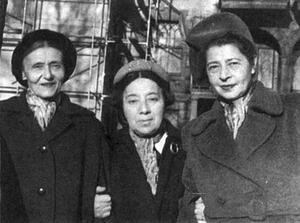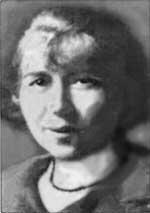Miryam Ulinover
Miriam Ulinover grew up in the city of Łódź, Poland, and spent some time in her childhood living with her grandfather in a shtetl. She began to write at a young age, choosing to write in Yiddish rather than the many languages spoken around her in Poland. Her poems were a response to the changing modern world and wove a vision of the shtetl as a place of Jewish memory, tradition, and life. Her work, which was deeply religious, spoke of faith, a close relationship to God, and the magical world of the Sabbath. However, Ulinover’s death in Auschwitz meant that much of her poetry went unpublished and has been lost.
With its feminine as well as religious perspective, original popular style and internal coherence, Miryam Ulinover’s poetry constitutes a chapter apart in Yiddish literature. As a personal response to modern man’s alienation and loss of cultural heritage, she created a mythical vision of a traditional Jewish (Yiddish) Small-town Jewish community in Eastern Europe.shtetl which—with subtle poetic means—stimulates the readers’ personal memories of childhood and offers a path to reconstruct their own identity. Although the world she depicts is thoroughly patriarchal, a prominent role is accorded to women, who are responsible for transmitting tradition and also capable of their own mystical experience. The deeply religious character of Ulinover’s work manifests itself in a full acceptance of existence, faith in divine justice and a strikingly familiar relationship with God. A special place is given to the Sabbath, with its magical atmosphere and cosmic dimension, in which the biblical world intertwines with our reality.
Early Life and Family
Little biographical information is available concerning Ulinover’s childhood and youth. She was born in Łódź Poland, as Miryam (Mania) Hirshbeyn, in 1888 according to the birth certificate (drawn up in 1890) or in 1890 according to other sources. Her parents, Shimen Hirshbeyn and Sheyndl, née Gerzon, were divorced in 1905. As a child Miryam spent some time with her grandfather Shaye Gerzon, a Lit. "teaching," "study," or "learning." A compilation of the commentary and discussions of the amora'im on the Mishnah. When not specified, "Talmud" refers to the Babylonian Talmud.Talmudic scholar, in the little town of Krzepice in Poland, near Czestochowa. This was her only contact with a Jewish shtetl and she lived the rest of her life in the city of Łódź.
Miryam was raised in a traditional, well-educated middle-class family and attended a high school (mitlshul) in Łódź. According to some sources, it was a meeting with Sholem Aleichem (1859–1916) during his visit to Łódź that encouraged her to write. As a young girl she wrote short prose texts in Polish, German and Russian and probably published some of them in the local press. In 1912 she married Volf Ulinover, a merchant from a A member of the hasidic movement, founded in the first half of the 18th century by Israel ben Eliezer Ba'al Shem Tov.Hasidic family. They kept a traditional household and had two daughters, Dine-Rokhl (b. 1915) and Hinde-Makhle (b. 1922). For a while Miryam worked in a grocery store that belonged to the family, but she stopped working after the birth of the children.
"Grandmother's Treasure": A Yiddish Poet
After her first literary attempts, she went over to Yiddish, which became the only language of her poetic expression. She was in touch with the well-known Yiddish writers H. D. Nomberg and I. M. Vaysenberg, who helped her publish her texts. Ulinover’s first attested publications, a short text in prose (the only one we have) and several poems, a few with war motifs and one with a traditional religious theme, appeared in 1915 in the periodical Di yetstige tsayt: a zamlung fun milkhome-literatur (Present Time: A Collection of War Literature). The poem “Dos ringl” (The ring), published in 1918 in Yugend (Youth), was translated into Polish and included in Shmuel Hirshhorn’s anthology Antologia poezji zydowskiej (Warsaw, 1921). Her poems also appeared in other magazines and yearbooks, such as Gezangen (Chants; 1919, 1920), Naye himlen (New Heavens, 1921) and the modernistic Ringen (Links, 1921).
The eminent Yiddish-Hebrew writer and critic Dovid Frishman helped Ulinover to publish a book of poems, Der bobes oytser (Grandmother’s Treasure, Warsaw 1922), to which he contributed an enthusiastic introduction. Although the book was a success, the critics let themselves be misled by the apparent “authenticity” and “folk simplicity” of Ulinover’s shtetl lyrics, and tended to regard them as merely autobiographical.
Despite this book’s success, none of her announced books (Khumesh-grusn, Shabes, In tate-mame-land, Dem zeydns oytser, Khelemyade) appeared in print. Throughout the 1920s and 1930s, Ulinover began new cycles of poems, like “Shabes” (Sabbath), part of which was published by Ezra Korman in his anthology Yidishe dikhterins (Yiddish women poets, Chicago 1928), “Inem shtetele der boben” (In grandmother’s shtetl) or “A grus fun der alter heym” (Greetings from the old home). Of her gently humorous “Lider fun Khelem” (Chelm poems) and “Lider fun alef-beys” (Poems of the alphabet), some appeared in the periodicals Inzl, Os and Haynt. She was one of the first Yiddish authors to draw on the folklore of the “fools of Chelm” and the Jewish alphabet. Ulinover usually published only a few poems a year, but, as recalled by Yerakhmiel Briks, she had many more in manuscript, including an unpublished cycle “Dem zeydns oytser” (Grandfather’s treasure). Although the literary press reported several times that she was about to publish a new book (like Khelemyade by Inzl publishing house or In tate-mame-land), none of them managed to appear before the outbreak of the war.
The Łódź Ghetto
Ulinover participated very little in the public cultural life of Łódź but several young writers, like Khaim-Leyb Fuks, Yitskhok Goldkorn, Rikudah Potash and Mirl Erdberg, most of them from traditional families, used to visit her in her apartment. This tradition of a literary circle continued also in the ghetto, where Miryam and her family were interned from February 1940. These literary gatherings sometimes included as many as fifteen writers, such as Yeshaye Shpigl, Simkhe-Bunem Shayevitsh, Alter Shnur or Yerakhmiel Briks. It seems that Miryam herself did not write in the ghetto, except perhaps for one short poem. With the liquidation of the ghetto in August 1944 she was deported to Auschwitz together with her family and perished in the gas chamber a few days later. None of her manuscripts were ever found.
After the war, although her name was sometimes mentioned in commemorative articles and her personality was given a quasi-legendary status, her poetry gradually fell into oblivion. A bilingual Yiddish-French edition of Ulinover’s collected works with a critical introduction, Un bonjour du pays natal/A grus fun der alter heym (Greetings from the old home), was published in Paris in 2003.
Selected Works
Der bobes oytser (Grandmother’s Treasure). Warsaw: Ha-Ahim Levin-Epshtayn un shutfim, 1922.
Der bobes oytser/Ha-ozar shel ha-savta (Grandmother’s Treasure, bilingual Yiddish-Hebrew). Translated by Yehoshua Tan Pai, introduction by Dov Sadan. Jerusalem: Mossad HaRav Kook, 1975.
A grus fun der alter heym/Un bonjour du pays natal, bilingual Yiddish-French, edited and introduction by Natalia Krynicka, poems translated into French by Batia Baum. Paris: Bibliothèque Medem, 2003.
“Overnight,” “The Encounter,” “Sabbath Candles,” “Alphabet.” Translated by Joseph Leftwich. In The Golden Peacock: A Worldwide Treasury of Yiddish Poetry, edited by Joseph Leftwich. New York–London: Thomas Yoseloff, 1961, 660–662.
“Havdolah Wine,” “The courtyard.” Trans. by Seth Wolitz. In Voices Within the Ark: The Modern Jewish Poets, edited by Howard Schwarts and Anthony Rudolf. New York: Avon Books, 1980, 366–367.
Fuks, Khaim-Leyb. “Miryam Ulinover un ir shrayber krayz.” Lodzh shel mayle: dos yidishe gaystike un derhoybene Lodzh. Tel Aviv: Y.L. Perets, 1972, 53–55.
Goldkorn, Yitskhok. “Miryam Ulinover.” In Lodzher portretn: umgekumene yidishe shrayber un tipn. Tel Aviv: Farlag ha-Menorah, 1963, 58–62.
Hellerstein, Kathryn. “Miriam Ulinover.” In Four Centuries of Jewish Women’s Spirituality, ed. by Ellen Umansky and Dianne Ashton. Boston: Beacon Press, 1992, 153–154.
Korman, Ezra. “Der bobes oytser.” Bikher-velt, 1 (January–February 1922), 35–37.
Krynicka, Natalia. (Introduction to) A grus fun der alter heym/Un bonjour du pays natal. Paris: Bibliothèque Medem, 2003, ה-צד XIII–LXXI.
Mayzil, Gitl. “Miryam Ulinover.” Eseyen. Tel Aviv: Y.L. Perets, 1974, 175–183.
Shpigl, Yeshaye. “Mit der dikhterin fun Der bobes oytser.” Geshtaltn un profiln: literarishe eseyen, Vol. 1, Tel Aviv: Farlag ha-Menorah, 1971, 219–223.
Turko, Yoysef. “Bay Miryam Ulinover,” Literarishe bleter 551 (November 30, 1934): 803.




